Destroying Myths: related to Elvis Presley
Supposed lost sales documentation & excluded units
1956-1958 sales
We start this listing of inflation tricks with a classic one: lost documents. It’s definitely easy to argue a lot of receipts have been lost through the decades for an artist who debuted in 1955 and with so many records out there. If you add to that the incredible creativity of some fans, you reach improbable arguments. Below text from Tony Galvin:
There are areas where Elvis has lost sales that have been documented and this would also add to his overall total. For instance the RIAA came into being in late 1958 and all pre 59 sales for all artists have been excluded from the current listings. To my knowledge this situation still exists and the approximately five million album sales from 1956-58 that Elvis sold are not included in his RIAA certifications.
Big claims out there. It’s common knowledge that measures of the RIAA are retrospective and that pre-1959 are eligible for certifications. Presley‘s own second album, 1956’s Elvis, was certified Gold in February 1960. Back then, an album had to register an extensive run at the top to reach that criteria making it completely ludicrous to expect that a 4-years old album made it on the back of a few months of catalog sales only. Galvin tries to back up his claim:
RCA claimed that Elvis sold 2.75 million albums by the end of 1956 […] There were only two Elvis albums released in 1956 (ELVIS PRESLEY LPM 1254 & ELVIS LPM 1382) and between them they officially only have a gold award each. The official figures for these two albums were obviously understated and it is clear to me that these gold awards were based on post 1958 sales leaving nearly three million units out of the equation. Likewise early sales for LOVING YOU/ ELVIS GOLDEN RECORDS/ ELVIS XMAS ALBUM & KING CREOLE have been omitted from the RIAA certifications. That would bring another five million units into Elvis total sales.
In the first part of his article, Galvin pretends to have gone through Jorgensen’s book A Life In Music to check his sales figures. Surprisingly, he forgets the latter stated the debut album Elvis Presley sold 300,000 units in 1956 while Elvis was released just before the end of year. The figure of 2,75 million is clearly a singles equivalent value. As already stated multiple times through our various article, the norm from the 50s to the 80s was to state figures using singles as the basis, counting EPs as 2 units and albums as 6 units (some labels / media used 5). Presley‘s first two albums shipped approximately 450,000 units during 1956, concluding on 2,75 million once multiplied by 6. Gold awards of these albums, reached in 1966 and 1960 respectively, were thus all-inclusive. So were all sales of albums like Loving You, Christmas Album, etc. Just like that, the article invents 8 million sales from a period (1956-1958) were Presley‘s top albums were moving under half a million units during their promotional campaign. Please find below a receipt of Presley‘s worldwide album sales up to 1965:

This is the back cover of the late 1965 LP Elvis For Everyone. The earlier albums were sold to consumers (the suggested list price) at $3,98 while dealers bought these units to RCA at around 65% of that price. Doing the math, albums issued from 1956 to 1958 sold 5,0 million by 1965, and that’s a worldwide figure.
Global figures stated as US ones
For example take the album GI BLUES, a platinum selling movie album only, but it sold 750,000 copies in it s first two months, 1.2 million copies by mid 1964 and it spent 111 weeks on the charts […] It is impossible in my mind to believe that this set in all it’s forms has not sold over two million copies, and probably much more […] To have not added a further half a million units over the next 35 years is inconceivable to me. There must have been a strong six figure sale for 1977 alone. I have been told but cannot confirm that one of the pressing plants contracted by RCA in 1977 to supply the massive demand for Elvis albums was the GREEN VALLEY RECORDS plant outside of Nashville Tennessee which had a capacity of 3000/5000 albums a day. This plant was supposed to have been contracted to produce only the GI BLUES album. For how long I do not know.
A clear case of wishful thinking taking over the reality. As we will see later in this article, these writings always claim Presley sold as much abroad than in the US. Conveniently, when data is reported for some albums, they act as if it was a US-only figure. Both numbers stated about G.I. Blues were global sales, as confirmed by the RCA receipt posted above. In the US, the album took two and a half years to reach Gold, which was worth over 650,000 units considering the dollar value requirements of the time. Bolded parts show the usual hyperboles we can read again and again in a lot of articles made by fans. It’s very important to be very careful when reading them.
Exclusion of reissues
More of the same, always from Galvin:
There is a similar story regarding new catalogue numbers as well as multiple formats for many of Elvis movie albums and I genuinely have difficulty believing that these albums have not managed to add an average of 100,000 odd sales in thirty years plus. If RCA/BMG kept these albums in continuous print for all that time they would have had to have sold less than 5000 copies a year to go over the gold mark
Thanks to Soundscan, we know that even the debut album Elvis Presley, arguably the most popular of his studio outputs, scanned only 108,000 from 1991 to 2010 under all its forms. Basically, 5,000 units a year is how much one of his top albums sold during the biggest era of the music industry with CD releases and remastered versions. Galvin is referring to soundtracks which have yet to go Gold, albums like Pot Luck and Fun in Acapulco. If the classic Elvis Presley can only sell 5,000 units a year, a realistic expectation would be under 1,000 units per year for these outdated items.
The pair of Brookville records
I mentioned the BROOKVILLE RECORDS TV advertised double album, ELVIS (DPL 2 0056) released in 1973 […] Launched at the time with the largest ever advertising budget in the history of the industry Stateside, it is widely believed to have been a winner for everybody with some claims of sales nearing ten million. The most conservative estimate I have seen is 3.5million […] BROOKVILLE RECORDS announced at the time of release that they were spending 3.5 million dollars on TV advertising a record for that time […] It is conceded by everybody that this set was a lucrative venture especially for RCA & BROOKVILLE and if this was the case the sales would have to have been well above the five million mark if not higher. I would base this assertion on the cost of manufacture, distribution, over the counter retail margin, license costs to RCA and the massive advertising budget. Based on a five dollar retail price BROOKVILLE would have had to sell over five million copies of the set to make a million dollars profit! […] The ROCKAWAY pressing plant in NEW JERSEY with a capacity of 60,000-80,000 albums a day was supposed to have exclusively concentrated on this album in the two months after Elvis died, according to BILLBOARD magazine.
I quote this large paragraph because it is the perfect example of implying fake figures while providing none. The advertising budget and the pressing plant capacity argument is something you will read in every Presley related article claiming a billion sales. It’s the perfect way to suggest massive sales while there is no evidence at all.
Once facts emerge they often tell a different story. This Brookville TV album titled Elvis from 1973 was certified 5xPlatinum in 2011 for 2,5 million sales, huge but nowhere near the 3,5-10 million ballpark claimed. The same goes to the second Brookville album, claimed to be on 2 million sales but certified for only 500,000 units sold. For the sake of accuracy, both albums did sell a more than their certified amount due to pricing issues – more on that over our next article – but still nowhere near to the 5-10 million claims.
A small step in Canada shows how these sales figures can be overstated:
I believe that this plant manufactured this album for the CANADIAN market as well as the US. Sales of MOODY BLUE in Canada were much higher than probably anywhere else in the world as a proportion of population, with over 800,000 copies sold there in the year after Elvis died.
In reality, the album Moody Blue went Platinum in October 1977 and 2xPlatinum in May 1978 in Canada. It appears Galvin isn’t aware of these official sources of information, instead relying on claims he read here and there through the years. It tells something key: always go by verified data before getting into dubious sources.
Record club sales
Another source for missing sales are the RCA & BMG RECORD CLUBS which are not to be under estimated as to their potential. Some specific releases from the RCA RECORD CLUB attained very substantial sales with for instance the club version of the WORLDWIDE GOLD AWARD HITS VOL 1 & 2 achieving platinum status
You read it well, “source for missing sales”. Trying to find “missing” sales isn’t the way to go. If we start arguing with similar arguments for all artists, it’s a highway for absurd inflation. In fact, Galvin contradicts himself while trying to support his claim. He goes on to say that albums can be issued in clubs only but still sell well, so well that they can reach Platinum. That’s absolutely true, but that also proves these albums are certified just like every other, thus they aren’t missing sales. As we will see, there have been Presley‘s records certified from virtually all relevant labels which leased his songs.
Leased products from 1973
Galvin isn’t the one looking for mysterious missing sales, Keene is just as creative:
For a start only a few scattered sales statistics exist for the period between March 1973 and January 1976,
Wow! This wild claim comes from the fact that Presley and his manager, Tom Parker, sold recordings’ rights to RCA in 1973. Some people don’t need more to argue sales receipts were lost. They back it with both Brookville and Pickwick releases that sold a lot of budget albums through the 70s without being certified. Jorgensen too mentioned them in 2001 while explaining why the RIAA tally of Presley isn’t higher:
- Brookville Record sales cannot at present be certified (7 x platinum – 2 albums)
- Another 5 to 7 million sales of Pickwick releases cannot be fully certified. Numbers are known, but they come from an audit report and not from actual sales accounting
We can clearly see that Keene, just like Galvin, was barely copying comments of Jorgensen who’s much more precise on his data. The point is: all Pickwick sales were certified in 2004. Their list below:

These albums were first issued by RCA / Camden but got licensed by Pickwick from 1973 to after the 1977 boost. Let’s have a quick overview at these famous Pickwick records:

Non-Pickwick column contains quick guess estimates of standard versions’ sales by the end of the 90s. These numbers fit with previous RIAA certifications, with figures published by Jorgensen as well as Billboard charts and the organic appeal of their track lists.
We can see clearly that Jorgensen comment about 5 to 7 million sales of Pickwick releases which cannot be fully certified was correct when he made it in his 2001 interview. The issue is that they were audited in 2004, but people like Keene continued to add them on top of the updated RIAA total.
The unique case of Frankie & Johnny
Another interesting film album from the sales point of view is FRANKIE & JOHNNY (ACL 7007). I believe it was the 1976 PICKWICK re issue of the soundtrack that received the PLATINUM award and it is also my belief that the sales of the original album LPM 3553 (approx 350,000 initial sales) are being treated separately.
All fans of Presley who tried to study his sales had that same belief. Facts prove the opposite though. As previously shown, these Pickwick editions were audited in 2004. It’s convenient to argue that Frankie & Johnny original album wasn’t considered in that award since it never went Gold previously. As many as 6 other albums reissued by Pickwick were certified both before and after the inclusion of these editions, showing they have all been merged together so there is no reason to expect a different treatment for Frankie & Johnny, especially since 1 million Pickwick sales is clearly very, very optimistic as we will see later.
